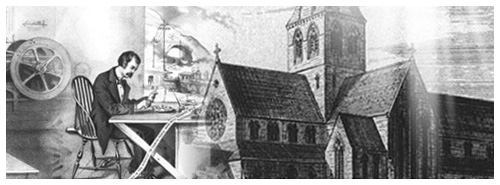
Catholic faith was kept alive in these lands during the Reformation period by the courage and loyalty of the Catholic nobility and gentry. Many of their sons were educated for the Priesthood in seminaries specially set up in Rome, Spain and France. Facing almost certain death, these brave young men returned from the continent in secret and travelled around the country to offer Mass, to instruct, to baptise, to marry and bury those whose faith survived the violent persecution of the 16th and 17th centuries.
This hidden network of Mass centres gradually emerged, as strict adherence to the penal laws slowly relaxed during the second half of the 18th century. Chapels serving as places of worship and schools were operating quietly in the back streets of many towns and cities by the time Catherine McAuley was born in 1778.

A new social order was developing in the wake of the Industrial Revolution and all the creative energy and wealth that this engendered. Many men and women such as Catherine, appalled by the social conditions and exploitation of the poor, were working for social and religious reform.
The powerful leadership of Daniel O’Connell and the political astuteness of the Duke of Wellington resulted in the Catholic Relief Act of 1791 and Catholic Emancipation in 1829, followed in 1850 with the restoration of the Catholic hierarchy of England, Scotland and Wales. A series of social reforms followed, some of which bear on our story. Successive Factory and Education Acts curtailed the age and hours that young children were allowed to work in the factories and mills.

Industrial Revolution, Cathedral of St. Barnabas Nottingham 1841
It was against this background that the active but low profile Catholic Church in England, Scotland and Wales threw caution to the winds and set itself to a strong, visible programme of evangelisation. During this period the famine in Ireland drove many people to seek work in the new industrial areas of the country. This swelled the population of the emerging parishes and created links between the Churches of both countries. Two other factors powerfully influenced this renewal and revival of the Catholic faith in these lands and they were to become intimately connected.
The most public statement and symbol of this emergence from the shadows was the building of great Gothic Churches on public highways by the talented Catholic architect Augustus Welby Pugin. These fine Churches which dominated the landscape were daring, courageous challenges to the status quo.
The Walking Nuns
A much quieter but perhaps more profound influence was the advent of ‘the walking nuns’ of Catherine McAuley. News of this new Congregation – the Sisters of Mercy – founded in Dublin in 1831 by Catherine McAuley was spreading rapidly.
The term walking nuns was derisive at first. Real nuns did not leave their Convents and walk the streets as Catherine’s Sisters did. However, it was soon realised that this new form of Religious life was God’s gift to His Church for this new and complex period in western society. Catherine’s Sisters visited the sick and poor in their own homes and in the dreadful hospitals of those days. They ran day and night schools for the poor, and where possible found shelter for the homeless and orphans. They sought in every way possible to improve the lot of women. It was exactly the support that the clergy of the newly re-established parishes needed.
Mercy Spreads
Invitations to Cat herine McAuley and her successors to set up Convents in Britain soon came thick and fast. In the ten short years of her Religious life she personally made two foundations in England – Bermondsey, London in 1839 and Handsworth, Birmingham in 1841. She visited the site for a third foundation in Liverpool in 1841 and received prospective candidates from Liverpool for their novitiate in Baggot Street. She died in November 1841 before the foundation to Liverpool was made. It was in August 1843 that the foundation in Liverpool was actually made and the Sisters moved into the Pugin designed Convent in Mount Vernon.
herine McAuley and her successors to set up Convents in Britain soon came thick and fast. In the ten short years of her Religious life she personally made two foundations in England – Bermondsey, London in 1839 and Handsworth, Birmingham in 1841. She visited the site for a third foundation in Liverpool in 1841 and received prospective candidates from Liverpool for their novitiate in Baggot Street. She died in November 1841 before the foundation to Liverpool was made. It was in August 1843 that the foundation in Liverpool was actually made and the Sisters moved into the Pugin designed Convent in Mount Vernon.



